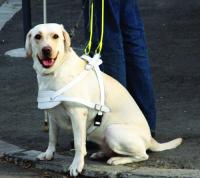 Introducing children to dogs and dogs to a child is in my mind always something to be done very carefully and with supervision of both the child and dog throughout the interaction always. Shilo and Cammy are both what we like to call "Mommy types" who are very tolerant of typical behaviors of small children for instance grabbing, poking, squealing, screeching, and falling but that doesn't mean that we let children run roughshod over them.Patience is, after all, a virtue with limits.
Introducing children to dogs and dogs to a child is in my mind always something to be done very carefully and with supervision of both the child and dog throughout the interaction always. Shilo and Cammy are both what we like to call "Mommy types" who are very tolerant of typical behaviors of small children for instance grabbing, poking, squealing, screeching, and falling but that doesn't mean that we let children run roughshod over them.Patience is, after all, a virtue with limits.One must also watch that dogs behaviors that are perfectly benign for an older child or adult like licks, sniffing or vocalizations don't scare or startle a small child. First impressions can have lasting affect on the relationship between child and dog.
- Ensure neither the child,the dog, or the supervising adult are cranky or tired at the time of interaction. Beings who are in these states have less patience for the new and unusual.
- Use your happy voice throughout the interaction
- Use cues your dog knows to keep the interactions under control and non- threatening such as Sit, Down, Off, Say Hi
- Help the child to gently pet and interact with the dog. With babies I tend to gently guide the hand they are reaching out for the dog with in small touches finished by a nice long stroke from me for the dog.
- If either child or dog get too excited with the interactions happily say your calming cue for your dog and take a break.
- Make sure the child or dog has nothing the other may want like food or toys before initiating interaction. Children and dogs both tend to live by the What's mine is mine and what I can get of yours is mine rules of possession so it's best not to involve high value items into the interaction.
- Always look for sign that either the child or dog are tiring or would like to move on. Keeping interaction short means that it is less likely anyone will loose patience.
 For more tips on kids and dogs read Advice and Tips Children and Dogs at home
For more tips on kids and dogs read Advice and Tips Children and Dogs at home 

 Fall and Winter Holidays
Fall and Winter Holidays
 Around the blocks, streets and parks of Bucharest, 51 year-old Gabi Nicolescu is walking the first guide dog for the blind in Romania – but no shop, hotel, cafe, taxi or bus will allow access to his three-year old Golden Labrador Chloe.
Around the blocks, streets and parks of Bucharest, 51 year-old Gabi Nicolescu is walking the first guide dog for the blind in Romania – but no shop, hotel, cafe, taxi or bus will allow access to his three-year old Golden Labrador Chloe. 











